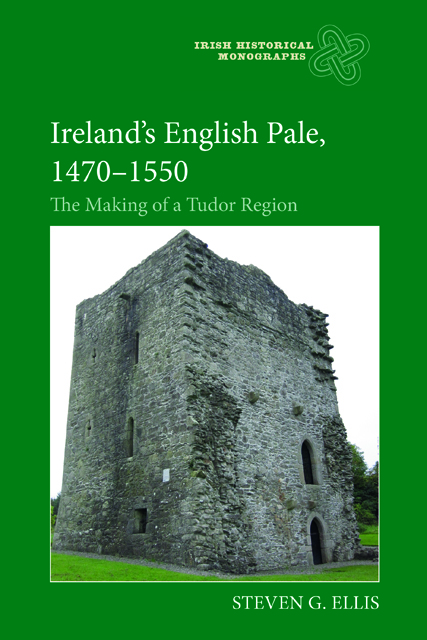Book contents
- Frontmatter
- Contents
- List of Maps
- Preface
- List of Abbreviations
- Introduction: in search of Ireland's English Pale
- 1 The horizons of English rule: retreat and recovery
- 2 The fortifications and identity of a military frontier
- 3 County Dublin and the military frontier
- 4 Strengthening the march in County Kildare
- 5 The English Pale's westward expansion: County Meath
- 6 The English Pale's northern frontier: County Louth
- 7 Restoring the English Pale, 1534-41
- 8 The waning of the English Pale
- Conclusion: an English region in Tudor Ireland
- Bibliography
- Index
- Irish Historical Monographs previous volumes
7 - Restoring the English Pale, 1534-41
Published online by Cambridge University Press: 09 January 2024
- Frontmatter
- Contents
- List of Maps
- Preface
- List of Abbreviations
- Introduction: in search of Ireland's English Pale
- 1 The horizons of English rule: retreat and recovery
- 2 The fortifications and identity of a military frontier
- 3 County Dublin and the military frontier
- 4 Strengthening the march in County Kildare
- 5 The English Pale's westward expansion: County Meath
- 6 The English Pale's northern frontier: County Louth
- 7 Restoring the English Pale, 1534-41
- 8 The waning of the English Pale
- Conclusion: an English region in Tudor Ireland
- Bibliography
- Index
- Irish Historical Monographs previous volumes
Summary
The creation of the English Pale as a means of improving the rule and defence of early Tudor Ireland was closely linked to the crown’s long-term reliance on successive earls of Kildare as governor. The success of this strategy reflected an effective concentration of public and private resources in this priority area and heartland of English rule. It combined the extensive landed possessions and manraed of a ruling magnate and the financial and military resources tradi¬tionally available to the Dublin government. In supervising the Pale’s rule and defence, experiments with alternative governors through the 1520s had shown that no other local magnate could convincingly step into Kildare’s shoes, and that entrusting the region to a governor and garrison from England would prove more expensive. Even after the 1534 rebellion, however, Henry VIII’s governing policy for Ireland remained deeply conservative. He sought to keep up the English Pale’s defences while identifying new sources of revenue, mainly from the church, with which to finance the upkeep of an English-born governor and garrison who, in the short term at least, were now necessary to replace Kildare. For the Tudor monarchy Ireland remained a low strategic priority, and after the revolt Henry VIII proved no more willing than before to contemplate Tudor rule there as an ongoing drain on his English resources.
Very quickly, the conduct of the king’s Irish government developed into a battle of wills between Henry and his advisers in Ireland. The king continued to insist that Ireland should be governed from its own resources; he clung to the English Pale as a minimalist but viable focus of English rule; and he rejected on grounds of cost all recommendations for a more expansive strategy. Irish officials kept up a continual lobby of proposals – in the form of so-called Tudor reform treatises – for the reduction of Ireland to obedience and good order: these would continue until the completion of the Tudor conquest. The English Pale, as the heartland of English rule in Ireland, remained the springboard for many of these proposals. Irish officials knew the country; but the king held the purse-strings and determined priorities.
The description of the Dublin region as ‘the English Pale’ signalled its development as a distinct region of the Tudor state.
- Type
- Chapter
- Information
- Ireland's English Pale, 1470-1550The Making of a Tudor Region, pp. 136 - 154Publisher: Boydell & BrewerPrint publication year: 2021



